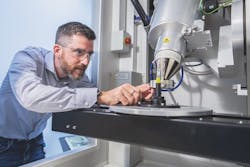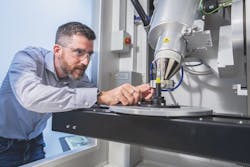OTTAWA, ON, CANADA and BOISBRIAND, QC, CANADA – The National Research Council of Canada (NRC) and Advanced Powders & Coatings, a GE Additive company (AP&C), have developed a new way to test the quality of powders used in 3D printing, leading to stronger, cleaner, safer, and more reliable 3D-printed parts for aerospace and medical devices.
The innovative method allows the detection of very low concentrations of foreign particles in powders using x-ray micro-computed tomography and 3D image analysis (FIGURE). Using this method, each individual foreign particle is visualized and size, brightness, and overall concentration are measured. In situations where cross-contamination is a concern, the technique is more sensitive and discriminating than current chemical analysis.
Dr. Fabrice Bernier, researcher at the NRC, analyzes powders used in 3D printing. (Courtesy: CNW Group/National Research Council Canada)
The new method was validated with titanium powders destined for production of aerospace parts, in collaboration with industrial partners. The teams are expanding their capabilities to other materials and metals, such as nickel alloys. The method could be very useful to qualify recycled powders in applications where safety is important.
“The competitiveness of 3D printing relies heavily on the capability of machine users to recycle their powders; however, the industry is concerned that foreign particles will be introduced in the feedstock as the powder is recycled,” says Frederic Larouche, executive vice president and chief technology officer at AP&C. “The method we are developing could help confirm that the feedstock maintains the utmost cleanliness during processing. Leveraging our complementary research and development competencies should help speed the development of 3D printing technologies. Our partnership with the National Research Council, a recognized research organization with deep expertise in powder metallurgy and materials characterization, is supporting Advanced Powders & Coatings’ growth and allows us to offer better integrated solutions to our partners.”
The National Research Council of Canada and AP&C are cooperating further on improving and developing metal powder characterization methods that are better adapted to the specific needs of the 3D printing industry. In addition to detecting foreign particles using x-ray micro-computed tomography, the NRC is working on the flow of metal powders during the 3D printing process, by measuring how spherical and porous particles are.
For more information, please visit www.nrc-cnrc.gc.ca and https://advancedpowders.com.

